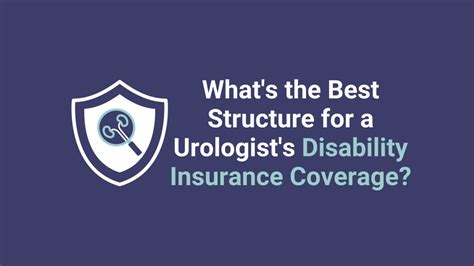Disability Insurance Coverage

Disability insurance is a crucial aspect of financial planning and risk management, providing individuals with a safety net in the event of an unexpected disability that impacts their ability to work and earn an income. This comprehensive guide aims to delve into the intricacies of disability insurance coverage, exploring its various facets, benefits, and implications.
Understanding Disability Insurance

Disability insurance, often referred to as DI or income protection, is a type of insurance policy designed to provide financial support to individuals who become disabled and are unable to perform their usual work duties. It serves as a vital component of a comprehensive financial plan, offering peace of mind and ensuring financial stability during challenging times.
The primary purpose of disability insurance is to replace a portion of an individual's income if they become disabled due to an illness, injury, or accident. It is especially crucial for individuals whose income is essential for meeting daily expenses and long-term financial goals. Disability insurance acts as a safety net, ensuring that even if one's earning capacity is compromised, their financial obligations can still be met.
Types of Disability Insurance
Disability insurance policies can be categorized into two main types: short-term disability insurance and long-term disability insurance. Each type serves a specific purpose and offers different levels of coverage and benefits.
Short-Term Disability Insurance (STD): As the name suggests, STD provides coverage for a relatively short period, typically ranging from a few weeks to a couple of months. It is designed to offer immediate financial support during the initial stages of a disability, when an individual may be unable to work but is expected to recover and return to their regular duties.
| STD Coverage Duration | Benefits |
|---|---|
| 2–3 weeks to 6 months | Provides income replacement during initial recovery |
| Varies by policy and provider | Offers financial support for essential expenses |

Long-Term Disability Insurance (LTD): In contrast, LTD policies are intended to provide long-term financial protection for individuals with disabilities that may persist for an extended period or even indefinitely. LTD coverage typically kicks in after the short-term disability benefits have been exhausted, ensuring continuous income support.
| LTD Coverage Duration | Benefits |
|---|---|
| 6 months to several years or until retirement | Provides long-term income replacement |
| Varies based on policy and individual circumstances | Offers financial stability for extended periods of disability |
Eligibility and Considerations
When considering disability insurance, several factors come into play, including age, occupation, health status, and personal financial goals. It is essential to evaluate one’s specific circumstances to determine the appropriate level and type of coverage needed.
- Age and Occupation: Younger individuals and those in lower-risk occupations may find it easier to obtain disability insurance at more affordable rates. However, as one ages or enters a higher-risk profession, the cost and availability of coverage may be impacted.
- Health Status: Pre-existing medical conditions or a history of illnesses can affect one's eligibility for disability insurance. Some policies may exclude coverage for certain conditions, so it is crucial to carefully review the policy terms.
- Financial Goals: Disability insurance should align with an individual's financial objectives. It is essential to assess one's income, expenses, and savings to determine the appropriate level of coverage needed to maintain their desired standard of living in the event of a disability.
Key Features and Benefits of Disability Insurance

Disability insurance offers a range of features and benefits that make it an invaluable component of financial planning. Understanding these aspects can help individuals make informed decisions about their coverage.
Income Replacement
The primary benefit of disability insurance is its ability to replace a significant portion of an individual’s income during a period of disability. Depending on the policy, disability insurance can provide anywhere from 40% to 80% of one’s pre-disability income, ensuring that financial obligations can be met despite the loss of earnings.
Customizable Coverage
Disability insurance policies can be tailored to an individual’s specific needs and circumstances. Policyholders can choose the level of coverage, the duration of benefits, and even the definition of disability that triggers the payout. This customization allows individuals to create a policy that aligns with their financial goals and peace of mind.
Tax Advantages
In many cases, disability insurance premiums are tax-deductible for self-employed individuals and business owners. Additionally, the benefits received from a disability insurance policy are often tax-free, further enhancing the financial protection it provides.
Protection for Specific Disabilities
Disability insurance policies can be designed to cover specific types of disabilities, such as occupational injuries, accidents, or illnesses. This targeted coverage ensures that individuals receive the necessary financial support for the specific challenges they may face.
Waiver of Premium
Some disability insurance policies offer a waiver of premium benefit, which means that if the policyholder becomes disabled and is receiving benefits, they may not need to pay premiums during the period of disability. This feature ensures that the policy remains in force without additional financial burden.
Portable and Flexible
Disability insurance policies are often portable, meaning they can be taken from one job to another or even if an individual becomes self-employed. This flexibility ensures that individuals maintain their coverage and financial protection regardless of their employment status.
Obtaining Disability Insurance
The process of obtaining disability insurance involves several steps, each of which is crucial to ensure one receives the appropriate coverage and benefits.
Assessing Needs
The first step in obtaining disability insurance is to assess one’s specific needs. This includes evaluating income, expenses, and the potential impact of a disability on one’s financial situation. Understanding the desired level of income replacement is key to determining the appropriate policy.
Researching Providers
There are numerous insurance providers offering disability insurance policies. It is essential to research and compare different providers to find the one that best suits an individual’s needs. Factors to consider include coverage options, policy terms, reputation, and customer service.
Understanding Policy Terms
Disability insurance policies can be complex, with various terms and conditions. It is crucial to thoroughly read and understand the policy before committing. Key considerations include the elimination period (the time between the disability and the start of benefit payments), the benefit period (the duration of coverage), and the definition of disability outlined in the policy.
Applying and Underwriting
Once an individual has chosen a provider and policy, they will need to complete an application and undergo an underwriting process. This involves providing detailed information about one’s health, occupation, and lifestyle. The insurer will assess this information to determine the risk and set the premium.
Disability Insurance in Practice
To illustrate the practical application of disability insurance, let’s consider a hypothetical case study.
Meet Sarah
Sarah is a 35-year-old graphic designer who recently decided to start her own business. As a self-employed individual, she understands the importance of financial protection and decides to explore disability insurance options.
Sarah’s Assessment
Sarah calculates that she needs to replace at least 60% of her pre-disability income to maintain her current standard of living. She also considers her expenses, savings, and long-term financial goals, such as saving for a house.
Research and Selection
After researching several providers, Sarah chooses a policy that offers customizable coverage and includes a waiver of premium benefit. The policy provides long-term disability coverage with a benefit period of 5 years, which aligns with her financial goals and peace of mind.
Underwriting and Premium
During the underwriting process, Sarah provides detailed information about her health and occupation. Based on her low-risk occupation and good health, she is offered a competitive premium that fits within her budget. She decides to purchase the policy, feeling confident that she has secured adequate financial protection in the event of a disability.
Real-Life Implications

Disability insurance can have a significant impact on an individual’s financial well-being and overall quality of life. Let’s explore some real-life scenarios where disability insurance has proven its worth.
Scenario 1: Accident and Recovery
Imagine John, a construction worker, who sustains a severe injury on the job, leaving him unable to work for an extended period. With short-term disability insurance, John receives financial support during his initial recovery, covering his medical expenses and daily living costs. Once his short-term benefits are exhausted, his long-term disability insurance kicks in, providing ongoing income replacement until he can return to work.
Scenario 2: Chronic Illness
Emily, a teacher, is diagnosed with a chronic illness that requires ongoing medical treatment and limits her ability to work full-time. Her long-term disability insurance policy provides her with a steady income, allowing her to focus on her health while still meeting her financial obligations. The policy’s benefits ensure that Emily can continue to afford her medical care and maintain her standard of living.
Scenario 3: Self-Employment Protection
David, a freelance web developer, experiences a sudden illness that prevents him from taking on new projects for several months. With disability insurance, he is able to receive income replacement during this period, ensuring that his business can continue to operate and he can meet his financial commitments. The portability of his policy allows him to maintain coverage despite his change in employment status.
Future Considerations
As individuals’ financial situations and needs evolve, it is essential to regularly review and update their disability insurance coverage. Here are some key considerations for the future.
Income Changes
As one’s income increases or decreases, it is crucial to reassess the level of disability insurance coverage to ensure it remains adequate. Regularly reviewing and adjusting coverage amounts can help maintain the desired level of financial protection.
Policy Updates
Insurance providers may introduce new policy features or improve existing ones. It is beneficial to stay informed about policy updates and consider whether any changes could enhance one’s coverage and peace of mind.
Changing Circumstances
Life events such as marriage, having children, or starting a business can significantly impact one’s financial situation and needs. It is essential to review disability insurance coverage in light of these changes to ensure that the policy remains aligned with one’s goals and provides the necessary protection.
Expert Insights
Disability insurance is a critical component of financial planning, and seeking professional advice can be invaluable. Financial advisors and insurance experts can provide tailored guidance based on an individual’s unique circumstances.
Conclusion
Disability insurance is a vital tool for individuals to safeguard their financial well-being and peace of mind. By understanding the different types of coverage, key benefits, and practical considerations, individuals can make informed decisions to protect themselves and their loved ones in the event of a disability. With the right disability insurance policy, individuals can focus on their recovery and continue to pursue their financial goals with confidence.
How much does disability insurance cost?
+The cost of disability insurance varies based on factors such as age, occupation, health status, and the level of coverage desired. On average, premiums can range from a few dollars per month for basic coverage to several hundred dollars for more comprehensive policies. It is advisable to obtain quotes from multiple providers to find the best fit for your budget and needs.
Can I have both short-term and long-term disability insurance?
+Yes, it is possible to have both short-term and long-term disability insurance policies. Having both provides comprehensive coverage for different durations of disability. Short-term disability insurance offers immediate financial support during the initial stages of a disability, while long-term disability insurance provides ongoing income replacement for extended periods.
What happens if I change jobs or become self-employed?
+Disability insurance policies are often portable, meaning they can be taken from one job to another or even if you become self-employed. This flexibility ensures that your coverage remains in place, providing you with continuous financial protection regardless of your employment status.



